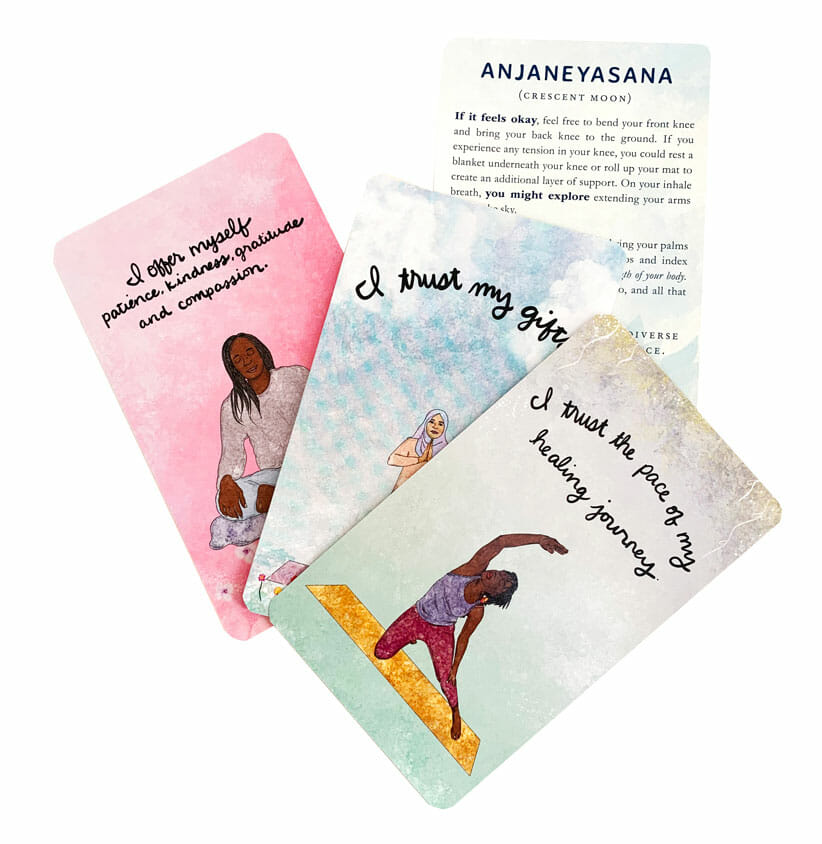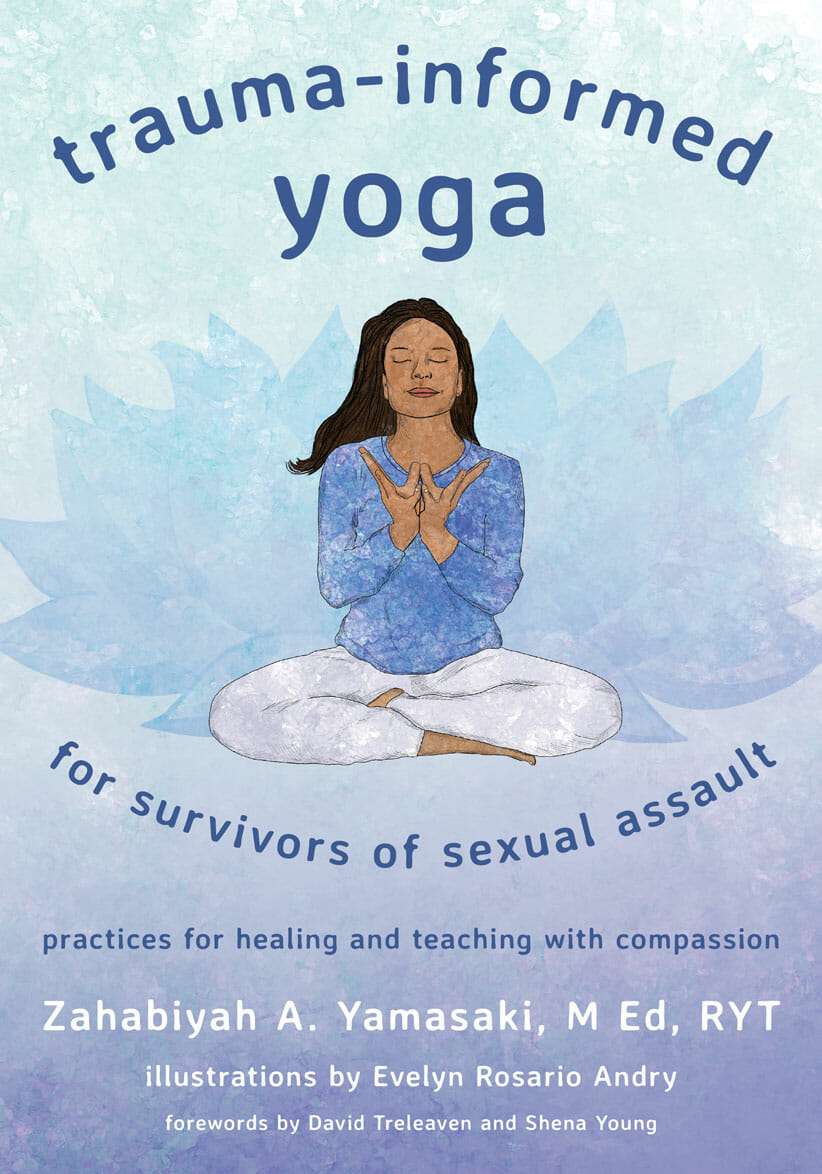How do I find a trauma-informed yoga class/instructor?
Cues for Trauma-Informed Yoga
“Know that the choices that you make with your body are absolutely celebrated in this space.”
“You are always in control of your practice.”
“You are your greatest teacher.”
“I invite you to send yourself gratitude just for arriving to your mat today. So often that is the hardest part.”
“I invite you to take a moment to reflect on your journey and how far you’ve come. Inhale and exhale at your pace.”
“Today explore taking up all of the space you deserve.”
“Know that you are welcome to leave the class at any time. Your comfort and safety are the most important elements of your practice.”
“All of you is welcome here.”
“Feel free to explore your own variations of the posture to increase your comfort. You are always invited to come out of the posture at any time.
“Rest is deeply personal. You have many options to explore what savasana looks like for you.”
“Know that you can keep your eyes open, close them, or find a soft gaze. This is your body and always your choice.”
“Allow being where you are to be enough. It is enough.”
“There are many ways to communicate your comfort level with assists. I honor your choices and you can change your mind at any time.”
Yoga Can Be A Practice of Empowerment
How did reading those cues land for you? We are all worthy of safe, compassionate, trauma-informed and empowering places to practice yoga. According to the National Council for Behavioral Health (2013), seventy percent of adults in the United States have experienced some type of traumatic event in their lives. I know that it goes without saying that the pandemic has also been incredibly traumatic and has revealed how unsustainable the pace many of us have been moving. Over the course of the past 20 months it has been incredibly challenging for folks to switch off their sympathetic nervous system. Living in constant states of hyperarousal is incredibly exhausting and can lead to adrenal fatigue. Our adrenals regulate the levels of cortisol in our bodies and adrenal fatigue can occur when our system is working in excess. This can ultimately lead to chronic fatigue, which can make even seemingly small tasks feel incredibly overwhelming. Please know that if this feeling is family to you: you are not alone. Additionally, we often replicate the busyness, the output, the pushing of our daily lives on our yoga mat and it can oftentime become a parallel process leaving very little room for moments of restoration. This is your compassionate reminder: your nervous system is worthy of rest.

Zabie Yamasaki photo by Leanne Sargeant
What is Trauma-Informed Yoga
Trauma-informed yoga is an empowering yoga practice that prioritizes the lived experience and healing of each and every student. Safety, trust, choice, and control are some of the core components of the practice.
Yoga can be a pathway for the integration of mind, body and spirit amid all of the disintegration that trauma causes. This notion alone has been a guide and anchor for me in my own healing and for creating affirmative and inclusive healing spaces. My work has been an intersection of my worlds as a survivor, a woman of color, and a trauma-informed educator and yoga instructor. Yoga is an ancient practice that began in India and seeks to help people transcend their suffering.

Affirmations from the Trauma-Informed Yoga Affirmation Card Deck
The National Sexual Violence Resource Center presents the following core frameworks of trauma-informed care:
* Safety
* Trust
* Choice
* Collaboration
* Empowerment
* Cultural Competence
Trauma-informed yoga is essentially integrating these frameworks into the way we teach and hold space. The core frameworks of teaching from a trauma-informed lens include:
* Empowering and invitational language
* Anti-oppression lens
* Accessibility
* Holding a safe container and supportive space
* Sensitivity to triggers
* Safety of the physical environment
* Trauma-sensitive breathwork
* Consent framework for assists
* Self and community care for teacher and students
I receive a number of inquiries from folks across the world who are looking for safe spaces to practice and want to find trauma-informed yoga classes and teachers. The Breathe Network is an amazing resource that connects survivors with healing-arts practitioners that offer sliding-scale, trauma-informed, and holistic support. Survivors can search by geographic location and/or modality to find practitioners in their area.
Additionally, there are questions you might ask yoga studios and teachers to find the right fit for you. Just like finding the right therapist is so essential, so is finding the right yoga teacher and space to practice. You are worthy of taking your time and asking intentional questions that center your needs. These concepts are further explored in my book Trauma-Informed Yoga for Survivors of Sexual Assault: Practices for Healing and Teaching with Compassion.

Here are some questions you might consider asking when looking for trauma-informed yoga classes:
* What is your consent policy around physical assists?
* How do you ensure your classes are accessible to those who have experienced trauma?
* Do you encourage students to rest and take classes at their own pace?
* Do you use supportive and invitational language?
* How do you ensure choice is central to the classes you teach?
* How do you create an inclusive environment in your studio?
* Do your teachers receive any form of trauma-informed training during their 200-hour certification?
* What does consent look like in your yoga community?
* Do you have gender-neutral restrooms?
Integration of Discussions around Trauma in Yoga Teaching
One day I envision that every yoga teacher training will integrate education about trauma in their curriculum. These are some philosophies that I hold tenderly.
What if, together, we could re-envision healing spaces in this world? If every yoga instructor and studio could do the following, it would support these processes.
* Knew that there were survivors taking their classes every single day. That many of their students are coping with PTSD, anxiety and depression. And that often their symptoms have continued to permeate their lived experience long after the trauma)s) occurred.
* Could learn about trauma in their 200 hour teacher training.
* Integrated trauma-sensitive breath options to support survivors in the inherent triggers related to breath work.
* Provided a variety of options for resting in savasana and were mindful of the common triggers related to trauma to the freeze response.
* Reminded students that they can leave class at any time.
* Had a plan for supporting students when they are triggered in class.
* Used gender neutral language and asked about pronouns.
* Affirmed their students just for showing up. Because we all know so often that is the hardest part.
* Knew that being trauma-informed should not be optional.
* Knew that the diversity of their teaching staff matters.
* Used invitational and empowering language so students were reminded often that they are enough exactly as they are.
* Reminded students of the power of celebrating the choices they have with their own bodies
* Asked themselves who they are not seeing come through their doors and why that is. And what changes could they begin making to create a more inclusive and safer environment?
* Applied the concepts of consent to the studio environment and every class they teach. What if each class was a celebration of the physical and emotional boundaries of their students?
* Were intentional about creating spaces for all bodies, folks in the LGBTQ community, and people of every race and ethnicity, socioeconomic status, and gender identity.
* Had gender neutral restrooms and safe spaces for people to change in.
* Had a consent affirming assist policy.
* Were reminded frequently that their healing matters, too.
Practice Trauma-Informed Yoga with Compassion
Lastly, I just want to say that intentionally choosing rest, space, and ease can be incredibly challenging for trauma survivors. Be gentle with yourself when it’s hard, pace yourself, and continue to take what you need. If possible, try and resist the urge to fill the space. When you have been accustomed to survival mode for so long, embodying this new way of being in the world may take time. Keep reminding yourself that you deserve the space both in your practice and in your life to know what deep rest feels like.
Zabie Yamasaki, M.Ed., RYT (she/her) is the Founder of Transcending Sexual Trauma through Yoga which is an organization that offers trauma-informed yoga to survivors, consultation for universities and trauma agencies, and training for healing professionals. Zabie has trained thousands of yoga instructors and mental health professionals and her trauma-informed yoga program and curriculum is now being implemented at over 25 college campuses and trauma agencies including the University of California (UC) system, Stanford, Yale, USC, University of Notre Dame, and Johns Hopkins University.
Zabie received her undergraduate in Psychology and Social Behavior and Education at UC Irvine and completed her graduate degree in Higher Education Administration and Student Affairs at The George Washington University. Her work has been highlighted on CNN, NBC, KTLA 5, and The Huffington Post.
Zabie is widely recognized for her intentionality, soulful activism, and passionate dedication to her field. She is a trauma-informed yoga instructor, resilience and well-being educator, and a sought after consultant and keynote speaker. She has worked with thousands of survivors to support them in their healing journey, ground them in their own worthiness and remind them they are inherently whole. Zabie centers survivors in her work, and provides them with tools to help uncover trauma imprints, support the healing process, create balance of the nervous system, and lessen the grip that past experiences of trauma may have on the heart.
She is a survivor, mother, partner, daughter, sister, friend, and activist. She has received countless awards in victim services and leadership, including the Visionary in Victim Services award from one of the largest rape crisis centers in California. Her book and affirmation deck published by Norton: Trauma-Informed Yoga for Survivors of Sexual Assault: Practices for Healing and Teaching with Compassion will be released in January 2022. It is currently available for pre-order.

